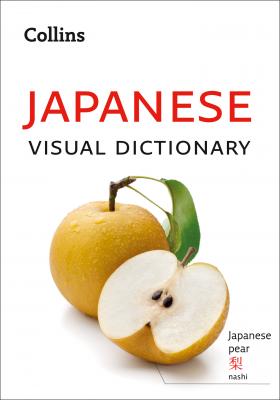Collins Japanese Visual Dictionary. Collins Dictionaries
Читать онлайн.| Название | Collins Japanese Visual Dictionary |
|---|---|
| Автор произведения | Collins Dictionaries |
| Жанр | Книги для детей: прочее |
| Серия | |
| Издательство | Книги для детей: прочее |
| Год выпуска | 0 |
| isbn | 9780008319939 |
Published by Collins
An imprint of HarperCollins Publishers
Westerhill Road
Bishopbriggs
Glasgow G64 2QT
First Edition 2019
© HarperCollins Publishers 2019
Collins® is a registered trademark of HarperCollins Publishers Limited
Ebook Edition © March 2019
ISBN: 9780008319939
Version: 2019-03-28
All rights reserved under International and Pan-American Copyright Conventions. By payment of the required fees, you have been granted the non-exclusive, non-transferable right to access and read the text of this ebook on screen. No part of this text may be reproduced, transmitted, downloaded, decompiled, reverse engineered, or stored in or introduced into any information storage and retrieval system, in any form or by any means, whether electronic or mechanical, now known or hereafter invented, without the express written permission of HarperCollins.
Entered words that we have reason to believe constitute trademarks have been designated as such. However, neither the presence nor absence of such designation should be regarded as affecting the legal status of any trademark.
HarperCollins does not warrant that any website mentioned in this title will be provided uninterrupted, than any website will be error free, that defects will be corrected, or that the website or the server that makes it available are free of viruses or bugs. For full terms and conditions please refer to the site terms provided on the website.
If you would like to comment on any aspect of this book, please contact us at the given address or online.
E-mail [email protected]
CONTENTS
Whether you’re on holiday or staying in Japan for a slightly longer period of time, your Collins Visual Dictionary is designed to help you find exactly what you need, when you need it. With over a thousand clear and helpful images, you can quickly locate the vocabulary you are looking for.
The Visual Dictionary includes:
10 chapters arranged thematically, so that you can easily find what you need to suit the situation
images – illustrating essential items
YOU MIGHT SAY… – common phrases that you might want to use
YOU MIGHT HEAR… – common phrases that you might come across
VOCABULARY – common words that you might need
YOU SHOULD KNOW… – tips about local customs or etiquette
USING YOUR COLLINS VISUAL DICTIONARY
The points below explain a few basic concepts of Japanese pronunciation and grammar and will help ensure that your Collins Visual Dictionary gives you as much help as possible when using Japanese:
1) There are several systems for writing Japanese in Roman characters, but the most understandable for English speakers is called the Hepburn system, which has been adapted slightly for use in this dictionary. Long vowels (pronounced with twice the length of normal vowels) have been written with a bar over the top, except for the double i:
ā ii ē ō ū
bus stop バス停 basu-tē
street 通り tōri
2) Japanese grammar is simple in many ways compared to European languages: there is no gender and there are no definite or indefinite articles; there is no difference between singular and plural; and verbs only have past and non-past (present or future) forms and do not change according to who is performing an action.
3) There are different levels of politeness in Japanese, but polite forms suitable for general use have been used in the phrases in this book.
Verbs are shown in the “plain” form. This is the form used among family members and close friends, and to form more complex structures, so you may hear people using it. However, it is safest to stick to using the polite form to avoid appearing over-familiar or rude. In the polite form, Japanese verbs end in “-masu”. Negative forms and
